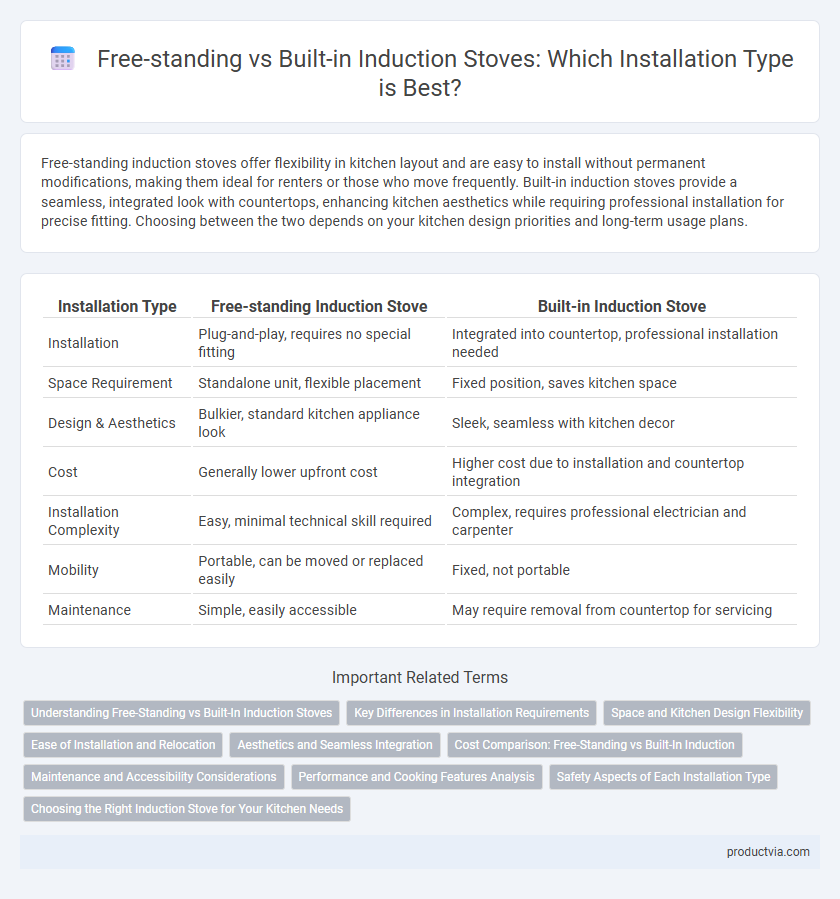Free-standing induction stoves offer flexibility in kitchen layout and are easy to install without permanent modifications, making them ideal for renters or those who move frequently. Built-in induction stoves provide a seamless, integrated look with countertops, enhancing kitchen aesthetics while requiring professional installation for precise fitting. Choosing between the two depends on your kitchen design priorities and long-term usage plans.
Table of Comparison
| Installation Type | Free-standing Induction Stove | Built-in Induction Stove |
|---|---|---|
| Installation | Plug-and-play, requires no special fitting | Integrated into countertop, professional installation needed |
| Space Requirement | Standalone unit, flexible placement | Fixed position, saves kitchen space |
| Design & Aesthetics | Bulkier, standard kitchen appliance look | Sleek, seamless with kitchen decor |
| Cost | Generally lower upfront cost | Higher cost due to installation and countertop integration |
| Installation Complexity | Easy, minimal technical skill required | Complex, requires professional electrician and carpenter |
| Mobility | Portable, can be moved or replaced easily | Fixed, not portable |
| Maintenance | Simple, easily accessible | May require removal from countertop for servicing |
Understanding Free-Standing vs Built-In Induction Stoves
Free-standing induction stoves offer flexible installation with built-in ovens and can be easily moved or replaced, making them ideal for renters or those who frequently update their kitchen layout. Built-in induction stoves provide a seamless, integrated look by fitting flush with countertops and cabinetry, enhancing kitchen aesthetics and saving space. Homeowners often choose built-in models for permanent installations where a modern, streamlined design is desired.
Key Differences in Installation Requirements
Free-standing induction stoves require minimal installation, often needing only a standard electrical outlet and no countertop modifications, making them ideal for flexible kitchen layouts. Built-in induction cooktops demand precise countertop cutouts and professional installation to integrate seamlessly with cabinetry, ensuring durability and aesthetic consistency. Power requirements also differ, with built-in units typically requiring a dedicated circuit to handle higher wattage safely.
Space and Kitchen Design Flexibility
Free-standing induction stoves offer greater flexibility for kitchen layouts due to their portability and ease of installation, making them ideal for renters or those who frequently rearrange their kitchen space. Built-in induction stoves integrate seamlessly into countertops, providing a sleek, modern aesthetic and maximizing countertop space for a streamlined kitchen design. Choosing between free-standing and built-in options hinges on available space and the desired level of customization in the kitchen's overall design.
Ease of Installation and Relocation
Free-standing induction stoves offer superior ease of installation and relocation due to their plug-and-play design, requiring no built-in cabinetry modifications. Built-in induction cooktops demand professional installation within countertops, making them more permanent fixtures that are harder to move once fitted. For users seeking flexibility and minimal setup time, free-standing models are the optimal choice.
Aesthetics and Seamless Integration
Free-standing induction cooktops offer flexible placement and easy installation but may disrupt kitchen aesthetics with visible gaps and seams. Built-in induction stoves provide seamless integration into countertops, creating a sleek, modern look that enhances overall kitchen design. Choosing built-in models supports a minimalist aesthetic and maximizes countertop space for a cohesive cooking environment.
Cost Comparison: Free-Standing vs Built-In Induction
Free-standing induction stoves typically have lower upfront costs due to easier installation and portability, often ranging between $500 and $1,500. Built-in induction cooktops, while offering a seamless kitchen design and more customized layout options, usually require professional installation and electrical work, increasing total expenses to $1,000-$3,000 or more. Long-term cost considerations include potential energy efficiency and kitchen remodeling expenses linked to built-in units versus the flexibility and lower replacement costs of free-standing models.
Maintenance and Accessibility Considerations
Free-standing induction stoves offer easier maintenance due to their standalone design, allowing full access to all sides for cleaning and repairs, which simplifies troubleshooting and replacement of parts. Built-in induction cooktops require more complex installation processes, often integrated into countertops, making accessibility for maintenance more limited and potentially costly if under-counter components need servicing. Choosing between these installation types depends on the balance between kitchen design preferences and the practicality of long-term upkeep.
Performance and Cooking Features Analysis
Free-standing induction stoves offer versatile placement with integrated controls and multiple cooking zones, providing high power output for rapid heating and user-friendly features like touch controls and timers. Built-in induction cooktops, designed for seamless kitchen integration, emphasize sleek aesthetics and often include advanced features such as bridge elements and precise temperature control for professional cooking performance. Performance analysis reveals that while both types deliver efficient heating and safety, free-standing models prioritize convenience and portability, whereas built-in units excel in custom kitchen design and enhanced cooking precision.
Safety Aspects of Each Installation Type
Free-standing induction stoves offer enhanced safety through their portability and integrated ventilation systems, allowing users to position the unit away from flammable surfaces. Built-in induction cooktops minimize the risk of accidental tipping or movement since they are securely fixed into the countertop, promoting a stable cooking environment. Both installation types feature automatic shut-off and child lock functions, but free-standing models may provide better safety in flexible kitchen layouts, while built-in units excel in preventing spills and maintaining a flush, secure surface.
Choosing the Right Induction Stove for Your Kitchen Needs
Free-standing induction stoves offer flexibility with easy installation and portability, making them ideal for renters or those who frequently change kitchen layouts. Built-in induction stoves provide a seamless, integrated look with permanent installation, enhancing kitchen aesthetics and saving counter space. Selecting the right type depends on kitchen size, design preferences, and whether a fixed or movable appliance suits your lifestyle.
Free-standing induction vs Built-in induction for installation type Infographic

 productvia.com
productvia.com